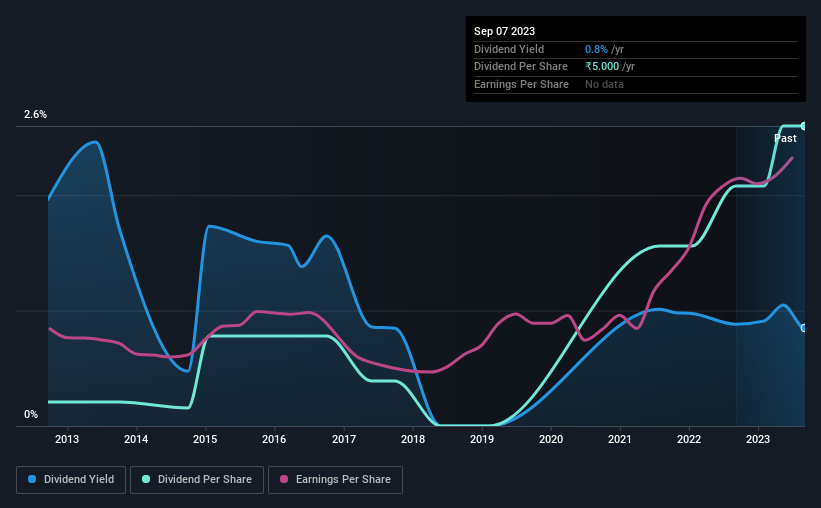- India
- /
- Metals and Mining
- /
- NSEI:GOODLUCK
Goodluck India (NSE:GOODLUCK) Is Increasing Its Dividend To ₹2.50

Goodluck India Limited (NSE:GOODLUCK) will increase its dividend from last year's comparable payment on the 30th of October to ₹2.50. Even though the dividend went up, the yield is still quite low at only 0.8%.
While the dividend yield is important for income investors, it is also important to consider any large share price moves, as this will generally outweigh any gains from distributions. Investors will be pleased to see that Goodluck India's stock price has increased by 38% in the last 3 months, which is good for shareholders and can also explain a decrease in the dividend yield.
See our latest analysis for Goodluck India
Goodluck India's Dividend Is Well Covered By Earnings
If it is predictable over a long period, even low dividend yields can be attractive. Based on the last payment, Goodluck India was earning enough to cover the dividend, but free cash flows weren't positive. In general, we consider cash flow to be more important than earnings, so we would be cautious about relying on the sustainability of this dividend.
If the trend of the last few years continues, EPS will grow by 34.8% over the next 12 months. Assuming the dividend continues along recent trends, we think the payout ratio could be 11% by next year, which is in a pretty sustainable range.

Dividend Volatility
Although the company has a long dividend history, it has been cut at least once in the last 10 years. Since 2013, the dividend has gone from ₹0.40 total annually to ₹5.00. This means that it has been growing its distributions at 29% per annum over that time. Goodluck India has grown distributions at a rapid rate despite cutting the dividend at least once in the past. Companies that cut once often cut again, so we would be cautious about buying this stock solely for the dividend income.
The Dividend Looks Likely To Grow
With a relatively unstable dividend, it's even more important to see if earnings per share is growing. It's encouraging to see that Goodluck India has been growing its earnings per share at 35% a year over the past five years. A low payout ratio gives the company a lot of flexibility, and growing earnings also make it very easy for it to grow the dividend.
In Summary
Overall, this is probably not a great income stock, even though the dividend is being raised at the moment. While the low payout ratio is a redeeming feature, this is offset by the minimal cash to cover the payments. We would probably look elsewhere for an income investment.
Companies possessing a stable dividend policy will likely enjoy greater investor interest than those suffering from a more inconsistent approach. Still, investors need to consider a host of other factors, apart from dividend payments, when analysing a company. Case in point: We've spotted 3 warning signs for Goodluck India (of which 1 is concerning!) you should know about. If you are a dividend investor, you might also want to look at our curated list of high yield dividend stocks.
New: Manage All Your Stock Portfolios in One Place
We've created the ultimate portfolio companion for stock investors, and it's free.
• Connect an unlimited number of Portfolios and see your total in one currency
• Be alerted to new Warning Signs or Risks via email or mobile
• Track the Fair Value of your stocks
Have feedback on this article? Concerned about the content? Get in touch with us directly. Alternatively, email editorial-team (at) simplywallst.com.
This article by Simply Wall St is general in nature. We provide commentary based on historical data and analyst forecasts only using an unbiased methodology and our articles are not intended to be financial advice. It does not constitute a recommendation to buy or sell any stock, and does not take account of your objectives, or your financial situation. We aim to bring you long-term focused analysis driven by fundamental data. Note that our analysis may not factor in the latest price-sensitive company announcements or qualitative material. Simply Wall St has no position in any stocks mentioned.
About NSEI:GOODLUCK
Goodluck India
Manufactures and supplies precision engineering and steel products in India.
Adequate balance sheet slight.
Similar Companies
Market Insights
Community Narratives



